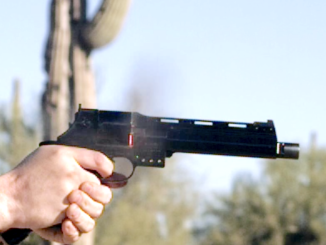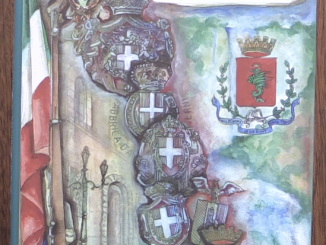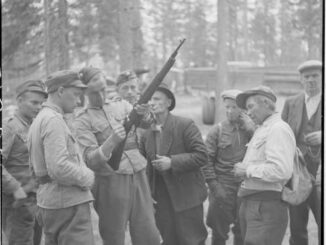Here in the United States, the Italian Vetterli is overwhelmingly found in the 1870/87/15 guise, and considered unsafe to shoot. However, this is simply the final transformation of a rifle which saw substantial military service and deserves more respect than the often-haggard examples here usually bring.
Robery Wilsey’s new book “The Italian Vetterli Rifle: Development, Variants, and History in Service” does a very nice job documenting the many different iterations of the Vetterli, including the story of its initial adoption and the experimental work surrounds each progressive update. The design began as a single shot 10.35mm weapon, was then upgraded with Vitali’s magazine (after trials with many other types), becomes a 4-round repeater. In addition to the common long rifle, both types were made in a variety of different lengths and configurations for guards, cavalry, etc. These would be again converted to the 6.5mm Carcano cartridge and the 6-round Mannlicher type magazine for WW1 service. As these rebuilds took place, a variety of other changes were made to the sights, safety, receiver, and other elements of the guns – all of which are documented here.
In addition to technical information on the guns, Wilsey has sections covering the ammunition, bayonets, and accessories associated with the system. He has a section on the Italian factories involved in both the manufacture and repair of the guns, and also a section on the far-flung conflicts where the Vetterli saw service (including Russia, Spain, Ethiopia, Libya, Ireland, China, the Balkans, and more).
Cover price is $49.99, and the book is available through Mowbray (the publisher), Amazon, and independent booksellers.




Speaking of books, it’s the first time I’ve ever peeped at that Chinn book, you folks always mention. Some sort of gun God he is, isn’t he. E= MC2 all that, mind bending.
Did John Browning know all that, or did he just try it etc.
And as a consequence, the “detailed” science followed. Or did said science precede the innovations initially. Kinda chicken and egg, were did gun designs start… Matchlocks, not what I mean.
So a question, if the “science” didn’t come first, does it perhaps now limit design? I.e. The box is all encompassing, now everything is contained within Pandoras box, and nobody wants to peek outside because it is a process that once begun generates many complicated problems- After solving so many problems previously in so much detail, it just isn’t worth it.
Isn’t it worth it, are we at the limit, everything has been done in every conceivable form over and over. A rhetorical question, he he.
“science”
Depend what you understand as science, but I would say it rarely “limit design”. Most important is cost-effect ratio and less available technology, with notion that used technology is often result of cost rather than non-existence of better technology.
Take for example:
rimless, bottle-neck case made from brass, jacketed Spitzer bullet
And guess about which cartridge it is – it might be .30-06 from early 20th century, 5,56×45 NATO from mid of 20th century or 4,6x30mm (for H&K MP7) from late 20th century. More advanced solutions in 20th century were developed and worked (for example caseless for H&K G11), but neither was adopted – these systems were deemed to costly in respect to potential gain.
Other such examples are .22 Long Rifle automatic pistols, this cartridge is archaic in following ways (in comparison to modern automatic pistol cartridges):
1) it is outside lubricated instead of inside lubricated
2) it is rim-fire not center-fire
3) as a consequence of 2) it is rimmed not rimless
4) it most often use lead bullets not FMJ (Ball in American parlance, however such .22 cartridges existed, namely BALL, CAL.22 LONG RIFLE M24)
5) relatively low working pressure
These attributes mean that (in comparison to modern automatic pistol cartridges):
1&4 cartridge must be rammed into chamber more delicate
2 priming is more “lazy” more powder is used for flash-ball generating instead of propelling bullet
3 crafting reliable magazines is more complicated, crafting high capacity magazines is more complicated
5 inferior ballistic, although there don’t exist, in our times, equivalent in size cartridge for comparison
Summing up: if anyone would today design new (from scratch) cartridge of similar-size designed purely for automatic pistol it might be superior in all that respects to .22 Long Rifle but no-one did it (so far I know) probably because it cost would be much higher
Other limitation in development are agreements (probably most known is limiting usage of DUM-DUM bullets) and rules, especially in shooting competition, see for example .221 Askins center-fire cartridge:
http://www.bullseyepistol.com/askins.htm
Knock, knock whos there.
Nobody.
Nobody who?
Wasn’t going anywhere.
Think of the birds, do they have jobs?
@Pdb: I don’t understand.
“Think of the birds, do they have jobs?”
This is question to me?
Monty python, the life of Brian- Sorry, impromptu reference.
Monty python, the life of Brian- Sorry, impromptu reference.
Thanks, I take your comment as “a hammer works” Thus, when you need hammers- You just want hammers, hammers which hammer…
But hammer requirements surely change, no point hammering on the top of your new Russian tanks- Nobody in the turret. Etc, etc.
So we can’t be restricted by, accepted hammer technology.
What is English term for моральное старение техники or моральный износ техники?
http://www.ngpedia.ru/id53223p1.html
Obsolete?
“Obsolete?”
Now I find Wikipedia query, linked to English Wikipedia Obsolescence, that is process of becoming obsolete.
Your country is vast and cold, it amazes me how anyone lives there.
Yet here you are.
Are you having a pleasant evening?
I often think how means of destroying opponent is turning to defeat the originator. Just look at some of the rifles we learned about. And very recently about DPM. I would have never thought Germans would feel need to use them.
“destroying opponent is turning to defeat the originator”
Greener police shotgun is example of try to make such situation harder.
Interesting example of owner-swapping is history of Sultan Osman-ı Evvel battleship:
https://en.wikipedia.org/wiki/HMS_Agincourt_(1913)
Which was originally for Brazil, later almost delivered to Turkey, but seized by Royal Navy as result of outbreak of First World War and named Agincourt (quite interesting name considering that in this war Great Britain will be ally of France) and used against Germany (ally of Ottoman Empire)
As a side note Ottoman Empire become ally of Germany in consequence of actions of Yavuz Sultan Selim bigcruiser:
https://en.wikipedia.org/wiki/Pursuit_of_Goeben_and_Breslau
which have influence on First World War (see chapter Long-term consequences)
Hi Ian,
My comment is on the prenounciation of “Carcano”. Back in 1963 when most of us heard about that name we heard the “press” calling it the Car-can-no. You said it like Car ka no. I trust you more than the talking heads back then. I noticed that you did not appologize for the way you pronounced it so am assuming that you know your way is correct.
As always, great video’s, keep up the great work. I look forward to seeing Forgotten weapons every day.
Yeah I noticed that too. I checked out the proper pronunciation and I believe Ian is incorrect. I think it’s Car-(Khan)-o.
I suspect that the “a”s are all as the a in cat. I will check with my favourite native speaker of Italian.
War “actual” is on the horizon.
https://youtu.be/CwggEQLd14Q
It may no longer be a matter of contracts to milk the cash cow, going forward- Something you should all think about, life and death.
“You can’t go up, alone”
I’m so cheerful.
Mirth.
Ah…
https://youtu.be/9czBBKof7Yo
What does уменьшить mean? Spunk bubble or??
I find google pictures a better translator for… Cyrillic, which is Greek to me.
“Cyrillic”
You probably mean grazhdanka
https://ru.wikipedia.org/wiki/Гражданский_шрифт
unless you are using Old Church Slavonic language?
I’m not that old…
“уменьшить”
decrease
Quite.
Wonderful script, like some sort of incarnation to summon up the devil.
“some sort of incarnation to summon up the devil”
If you like challenges, can you read this:
http://ultrafactsblog.com/post/151494334086/ultrafacts-dearest-creature-in-creation
without fails and stoppages?
Clever guy.
I can kinda see what they’ve done.
And I wish Russia all the best, under Putin. Sickened me to see the decline in 90’s folk drinking antifreeze etc, to achieve liberal democracy.
There’s no animosity to Russians in Britain you know. We weren’t Nazis, there’s no reason to irrevocably fall out.
We have a Queen, and Socialism- To an extent, better than killing each other, I’m sorry we killed Russians in your civil war.
But we aren’t, perhaps what your becoming- Religion died here,as a consequence of killing each other via sectarianism.
Hey Pillsbury, are you free-wheeling again? No, I do not mind, I just learn more about you. U are unusual and quite tasty cookie. Oh yeah, and pardon my French.
A war of muses.
http://www.telegraph.co.uk/news/2017/04/08/boris-johnson-spearhead-diplomatic-drive-get-russian-forces/
Ian,
Have you done a video with your Vetterlis?
C&Rsenal have a few pieces up, but besides that there is next to nothing technical on the webz about these wonderful old (and grossly ignored) guns.
Incidentally, what is the price range for Vetterlis in the united state? Theyre about €800 to €1200 in Italy for an Italian one and €1200 for a nice Swiss one.
______________
Greetings Denny, hoping that you are well!